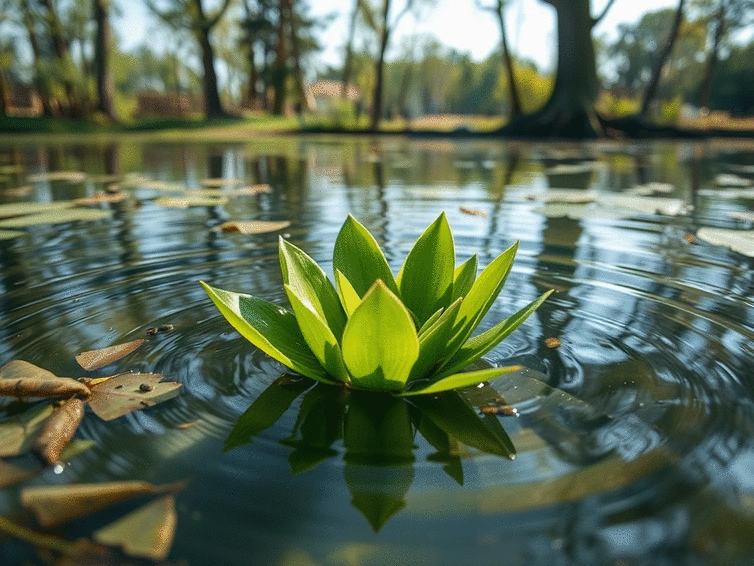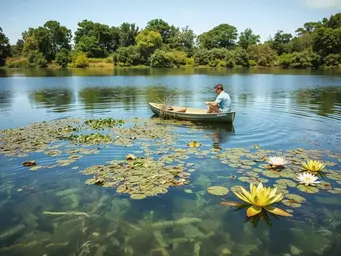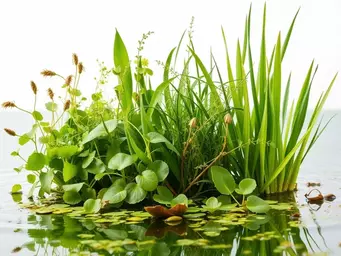Identification: Key Features
- Long, narrow leaves whorled around stem
- Bright green (reddish in dry conditions)
- Forms dense underwater mats

The journey to understanding aquatic ecosystems begins with recognizing the hidden challenges that lurk beneath the surface. One such challenge is the invasive Southern Naiad, a plant that can swiftly disrupt the balance of your pond. By learning to identify this species and its characteristics, you can take proactive steps to protect your aquatic environment.
Understanding Southern Naiad involves recognizing its distinct features, preferred growth conditions, and the significant ecological impact it has on aquatic environments. The visual below summarizes these critical aspects.
Have you ever gazed into the calm waters of your pond and noticed a peculiar plant floating just beneath the surface? That might be Southern Naiad, a common aquatic weed that can quickly become a nuisance if left unmanaged. At Aquatic Weed Solutions, I’m dedicated to helping landowners like you recognize and control this invasive species to restore the natural balance of your aquatic ecosystem.
Identifying Southern Naiad is the first step in effective management. With its distinctive features and growth patterns, you can pinpoint this species in your pond before it takes hold.
Southern Naiad typically grows submerged in water, with its leaves resembling a feathery or branching appearance. The plants can grow up to three feet long, often forming dense underwater beds. Notably, the leaves are slender and whorled around the stem, creating an elegant yet invasive structure. This characteristic can make it challenging to differentiate from other native plants, so it's crucial to familiarize yourself with its unique traits. For detailed identification resources, you can refer to information provided by Penn State Extension.
Not only can these mats choke out native vegetation, but they can also hinder recreational activities in your pond. Understanding the physical description of Southern Naiad will help you identify it early on!
As I mentioned earlier, Southern Naiad's distinctive leaf arrangement is key to identification. It thrives in shallow waters, often found in ponds and lakes with slow-moving water. This aquatic plant is capable of rapid growth, especially in warm months, and can spread through fragments, making it difficult to control once established. More information on its characteristics can be found through resources like the UC Davis Weed Research & Information Center.
Throughout the year, Southern Naiad undergoes remarkable changes. During the spring and summer, this plant appears lush and vibrant, thriving in warm temperatures. However, as temperatures drop in the fall and winter, you may notice it transforming, sometimes even appearing wilted or dormant. Understanding these seasonal shifts can help you monitor your pond’s health and prepare for potential management strategies.
To effectively manage Southern Naiad, it’s important to recognize where it’s likely to thrive. This plant prefers specific conditions that can lead to its proliferation in your pond.
Identifying these conditions in your pond can help you take preemptive measures to limit Southern Naiad's growth.
Ponds that are warm, shallow, and enriched with nutrients create an ideal environment for Southern Naiad. Stagnant water, often found in less-maintained ponds, encourages its quick spread. When you assess your pond, look for areas where water circulation might be limited, as these are prime spots for this invasive plant.
If you're noticing a rapid increase in algae blooms or declines in native plant diversity, these could be signs of Southern Naiad invasion. Monitoring your pond’s health is essential. I recommend keeping an eye on the following:
Being vigilant about these indicators can help you manage Southern Naiad before it becomes a larger problem.
The presence of Southern Naiad can have profound effects on your pond’s ecosystem. Understanding these impacts is critical to maintaining a healthy aquatic environment.
Recognizing these ecological impacts allows you to take informed action against this invasive species.
Southern Naiad's aggressive growth pattern poses a significant threat to local biodiversity. It can smother native aquatic plants, reducing habitat for fish and other wildlife. As a passionate ecologist, I emphasize the importance of maintaining biodiversity in your pond. By addressing Southern Naiad early, we can help protect the delicate balance of life in our waterways.
As we manage Southern Naiad, we must consider its effects on water quality. This invasive weed can lead to reduced oxygen levels and increased nutrient loads, which can affect fish populations and overall ecosystem health. By actively managing this plant, we not only improve water quality but also promote habitat restoration, ensuring a thriving aquatic environment for future generations.
Southern Naiad can double its biomass in just a few weeks under optimal conditions! This rapid growth can lead to significant challenges in managing your pond's ecosystem. Staying vigilant and proactive can help you stay ahead of this invasive species.
Southern Naiad is an invasive aquatic plant characterized by long, narrow leaves whorled around its stem, often forming dense underwater mats. It is typically bright green but can turn reddish in dry conditions. It thrives submerged in shallow, nutrient-rich waters.
This plant flourishes in shallow waters (1-5 feet deep) with moderate to high nutrient levels and still or slow-moving water bodies. Ponds with limited water circulation and abundant nutrients are ideal environments for its rapid spread.
Southern Naiad aggressively outcompetes native plant species, leading to a loss of biodiversity. Its dense mats alter aquatic habitats, disrupting breeding grounds for fish and other wildlife. As it decays, it degrades water quality by lowering oxygen levels.
Management strategies include manual removal for small infestations, herbicide application (such as Dibrox or Aquathol) for larger areas, and biological controls like the introduction of grass carp. A combination of these methods is often most effective.
If your pond experiences significant weed growth hindering recreational use, if multiple control attempts have failed, or if you are unsure about herbicide application regulations, it is advisable to consult with aquatic management professionals.
In our journey through the world of Southern Naiad, we’ve explored vital aspects of its identification and control. Recognizing its unique characteristics is crucial for effective management. Remember, Southern Naiad often exhibits long, slender stems and can grow submerged or partially above water. The leaves are narrow and can be easily mistaken for other aquatic plants, which is why careful observation is key!
When it comes to control techniques, it’s important to utilize a combination of methods tailored to your specific pond conditions. Here’s a quick recap of essential strategies:
Utilizing these techniques can help maintain a balanced and healthy pond ecosystem. Stay alert for changes in your pond and adapt your management strategies as needed!
As a pond owner, taking proactive steps is essential to prevent Southern Naiad from taking over. Regular monitoring and maintenance can make all the difference. Here are some key actions I recommend:
Embracing these steps will empower you to effectively manage your pond, ensuring it remains a thriving aquatic habitat!
Sometimes, despite our best efforts, Southern Naiad can be challenging to control. If you find that your control methods aren't yielding results, it may be time to consult with professionals. Here are a few indicators that it’s best to seek help:
Engaging experts can provide tailored solutions and peace of mind, allowing you to focus on enjoying your pond!
To enhance your pond management skills, consider exploring various resources that provide valuable information. Here are some options to get you started:
These resources can equip you with knowledge and strategies to better manage your aquatic ecosystem!
Awareness of local regulations is a critical aspect of managing Southern Naiad effectively. Each state has specific guidelines regarding the use of herbicides and the introduction of biological controls. Familiarizing yourself with these laws ensures compliance and promotes responsible management practices. You can often find this information through local environmental agencies or extension services.
Building community awareness around invasive species like Southern Naiad can lead to more robust management efforts. Engaging with local stakeholders and participating in community meetings helps share knowledge and resources. Consider organizing or joining events that focus on aquatic ecosystem health, fostering a collaborative approach to managing our precious waterways!
Here is a quick recap of the important points discussed in the article:
Managing Aquatic Weeds Effectively

As we delve into the hidden challenges of our water ecosystems, understanding the role of aquatic we
Impact of Aquatic Weeds on Recreation

As we dive into the world of aquatic ecosystems, the presence of invasive aquatic weeds may not only
Understanding Aquatic Weed Varieties

What if understanding aquatic weeds could be the key to restoring our waterways? As we dive deeper i
Managing Aquatic Weeds Effectively
Impact of Aquatic Weeds on Recreation
Understanding Aquatic Weed Varieties
Integrated Aquatic Weed Management Methods
Integrated Approaches to Aquatic Weeds